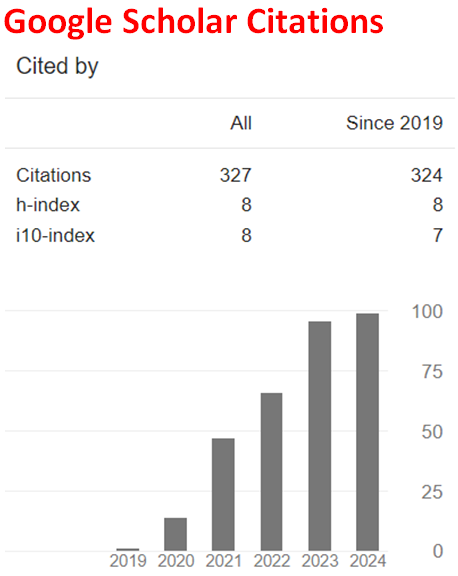Study of the Microbial Composition and Comparative Biogas Production from Fresh, Dried and Cow-Dung Seeded Pumpkin (Cucurbita maxima) Residue
Abstract
The research study was aimed at identifying the microorganism(s) associated with biogas production as well as comparing the biogas production potential of the fresh, dried and cow dung seeded pumpkin wastes as substrate. The samples were procured from different fruit seller locations within Sokoto metropolis and the study conducted within a period of five weeks (35 days). Standard microbiological methods were used for isolating and identifying the microbes while fabricated anaerobic bio-digesters were used to ascertain the biogas production from the substrates. Analysis revealed that the pH varied between 6.30 to 7.20 and 5.0 to 6.2 before and during/after the anaerobic digestion respectively. Anaerobic bacteria isolated were identified as Enterobacter spp and Escherichia coli. The results showed 4850, 1430 and 1770 cm3 biogas production from the fresh, dried and cow dung co-seeded substrates respectively during the retention periods with a calorific value of 4773 kcal/kg. The volume of biogas produced varied significantly (p<0.05) between the substrate treatments and the digestion intervals (days). GC-MS analysis confirmed the identity of the produced methane. This study confirmed the role of bacteria as well as the capability of the substrate to produce biogas production in an in vitro bio-digester system.
Downloads
References
A.M. Mshandete, and W. Biogas Parawira, Technology Research in selected sub-Saharan African, African Journal of Biotechnology 8(2) (2009), 116-125.
S. Baba, U. Shedu, I. Abubakar, and I. Nasir, Anaerobic digestion of cow dung for biogas production, ARPN Journal of Engineering and Applied Sciences 7 (2012), 169-172.
S. Ezeohu, I. Dioha and N. Eboatu, Daily biogas production from different wastes and identification of methanogenic bacteria involved, Nigerian Journal of Solar Energy 15 (2005), 80-85.
C. Madu and O. Sodeinde, Relevance of biomass in the sustainable energy development in Nigeria, Proceedings of the National Engineering Conference and Annual General Meeting of the Nigerian Society of Engineers (2001), 220-227
A.A. Biogas Abubakar, Potential of some selected kitchen wastes within Kaduna metropolis, American Journal of Engineering Research 6 (5) (2017), 53-63.
B.S. Sagagi, B. Garba and N.S. Usman, Studies on biogas production from fruits and vegetable waste, Bayero Journal of Pure and Applied Sciences 2(1) (2009), 115-118. https://doi.org/10.4314/bajopas.v2i1.58513
O.L. Adeyosoye, L.A. Adesokan, K.D. Afolabi and A.H. Ekeocha, Estimation of proximate composition and biogas production from in vitro gas fermentation of sweet potatoe and wild cocoyam peels, African Journal of Environmental Science and Technology 4(6) (2010), 388-391.
G. Bitton, Wastewater Microbiology, A John Wiley & Sons Inc. Publication, 3rd ed., Hoboken, New Jersey Chap. 13, 2005, pp. 345-369.
M.H. Gerardi, Wastewater Microbiology Series: The Microbiology of Anaerobic Digesters, John Wiley and Sons, Inc., New York, 2003. https://doi.org/10.1002/0471468967
C.O. Nwuche and E.O. Ugoji, Effects of heavy metal pollution on the soil microbial activity, Int. J. Environ. Sci. Technol. 5(3) (2008), 409-414. https://doi.org/10.1007/bf03326036
C. O. Nwuche and E. O. Ugoji, Effect of co-existing plant specie on soil microbial activity under heavy metal stress, Int. J. Environ. Sci. Technol. 7(4) (2010), 697-704. https://doi.org/10.1007/bf03326179
I. Angelidaki, L. Ellegaard and B.K. Ahring, A mathematical model for dynamic simulation of anaerobic digestion of complex substrates: focusing on ammonia inhibition, Biotechnology and Bioengineering 42 (1993), 159-166. https://doi.org/10.1002/bit.260420203
B. Garba, A. Zuru and A.S. Sambo, Effect of slurry concentration on biogas concentration from cattle dung, Nigeria Journal of Renewable Energy 4 (1996), 38-43.
A. Aderonke, A. Wasiu and O. Moses, Isolation and characterization of microorganisms with hydrolytic profile during anaerobic digestion and biogas production of cow dung and rice husk, Journal of Natural Sciences Research 7(5) (2017), 20-30
J.G. Holt, N.R. Krieg, P.H.A. Sneath, J.T. Stanley and S.T. Williams, Bergey’s Manual of Determinative Bacteriology, 9th ed., Williams & Wilikins, Baltimore, 1994.
T. Gregersen, Rapid method for distinction of gram-negative from gram-positive bacteria, European J. Appl. Micobiol. Biotechnol. 5(2) (1978), 123-127. https://doi.org/10.1007/bf00498806
O. Odeyemi, Biogas generation from cassava leaves compared with two animal manures and sewage sludge, Review in: Energy in Biogas Industries, Pergamon Press, Oxford, 2004, pp. 554-558.
B.A. Adelekan, and A.I. Bamgboye, Comparison of biogas productivity of cassava peels mixed in selected ratios with major livestock waste types, African J. Agric. Research 4(7) (2009), 571-577.
B.E. Asikong, S.O. Idire and D.R. Tiku, Microorganisms associated with biogas production using vegetable (Telfairia occidentalis) wastes, banana peel and pig dung as substrates, British Microbiology Research Journal 16(3) (2016), 1-12. https://doi.org/10.9734/bmrj/2016/28294
S. Harban, S. Sarabjit and S. Sukhwinder, Calorific Value of Briquettes from Various Raw Materials for Fuel, 2013, pp. 760-766.
S. Jaenicke, C. Ander, T. Bekel, R. Bisdorf, M. Dröge, K.-H. Gartemann et al., Comparative and joint analysis of two metagenomic datasets from a biogas fermenter obtained by 454-phyrosequencing, PLoS ONE 6(1) (2011), e14519. https://doi.org/10.1371/journal.pone.0014519
B. Demirel and P. Scherer, The roles of acetotrophic and hydrogenotrophic methanogens during anaerobic conversion of biomass of methane, Rev. Environ. Sci. Biotechnol. 7 (2008), 173-190. https://doi.org/10.1007/s11157-008-9131-1

This work is licensed under a Creative Commons Attribution 4.0 International License.


